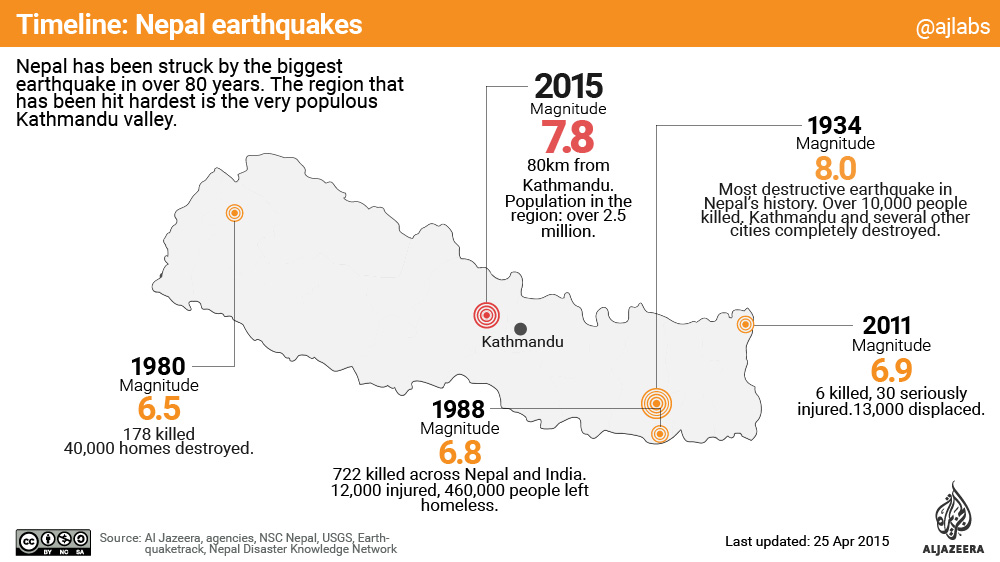Aid reaches Nepal epicentre, but little relief felt
Remote village in Gorkha district reels from massive devastation, with more than 90 percent of houses destroyed.

The village in Nepal’s eastern Gorkha district is tiny but the devastation it has encountered is massive.
“I still haven’t been able to comprehend what happened, and how we’ll recover from this disaster,” says 74-year-old Durga Prasad Kattel.
Keep reading
list of 4 itemsWhy Egypt backed South Africa’s genocide case against Israel in the ICJ
US sanctions two RSF commanders as fighting escalates in Sudan’s Darfur
Israel’s war on Gaza updates: 600k displaced from Gaza since May 6 – UN
Clutching a walking stick, Kattel leads me through the small mountainside enclave, approximately 50km from the epicentre of the earthquake.

As we pass residents, digging through rubble and picking up pieces of their collapsed homes, Kattel tells me 200 people live here and that 90 percent of the houses here were destroyed.
Kattel built his own home 58 years ago. Now it’s completely gone.
My team and I travelled here with World Health Organisation staff members.
Underscoring how perilous the situation remains, as we were en route, a 5.1 magnitude aftershock strikes.
It is very brief, lasting only seconds, but absolutely terrifying.
That’s just one reason why, even while aid is being delivered, residents are no closer to feeling relieved.
“We don’t know how we’re going to live through monsoon season in this condition,” Kattel tells me.
Facilities destroyed
Of far more immediate concern to the WHO and many other aid organisations, is what might happen in Gorkha – and the rest of Nepal – even before the rainy season begins in June.
“We believe that most of the water sanitation facilities have been destroyed,” explains Dr Hyo-Jeong Kim, WHO’s emergency operations manager.
“And that increases, by the day, the concerns for possible outbreaks of communicable diseases.”
As boxes full of medication, water-purification tablets and more are being distributed, WHO workers assess the area’s needs and make the decision to establish a field office in Gorkha.
“There are more than 13,000 people that haven’t been reached, that we have no idea what’s going on,” Kim, says.
![Most of the houses in Katteldanda have been destroyed by the magnitude 7.8 quake [Mohammed Jamjoom/Al Jazeera]](/wp-content/uploads/2015/05/9b04b3c348734021acf2d78b03c91d65_18.jpeg)
“So the most important thing for us is to make sure that we get help out there as soon as possible.”
A short drive away sits the Gorkha district hospital.
Upon arrival, it takes but one quick glance around to see how dire the situation is.
With lines out the door, young and old await treatment. Their faces show clearly how much pain they were in.
While more aid teams have arrived and more medicine is being dispensed, it’s still not nearly enough.
Bishnu Maya Sirmal, 54, was injured in the tremor earlier. After the tremor, things only got worse.
Scared, weak and in pain
“My husband and son are both alcoholics,” she says, “My daughters are married and living elsewhere.”
Scared, weak and in pain, she was forced to seek treatment on her own.
“I had to walk for half an hour to get to the hospital,” she says.
The treatment Sirmal gets gives her some comfort, but not enough. Now, she has no idea how she’ll get be able to home.
Back at Katteldanda village, as rattled and traumatised as the residents are, some of them feel fortunate.
For they are all too aware that other parts of Gorkha were much harder hit.
Kattel, for one, would certainly welcome more aid and assistance, but says they know better than to wait for it.
“We can’t just sit around expecting the government’s help,” Kattel tells me.
“We all survived the earthquake, there is no casualty in this village. We’ll survive and manage somehow.
“We’ll get through this.”
Nikita Tripathi contributed to this report